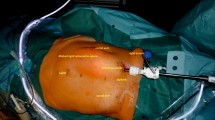Abstract
Background
Totally extraperitoneal repair (TEP) is the preferred method of inguinal hernia repair for many surgeons worldwide. However, because of limited working space, there may be difficulties when operating on large and irreducible groin hernias and short stature patients. There are many ways in which the port positions can be modified during TEP for different kinds of hernias and according to the comfort of the surgeons.
Methods
This is a retrospective analysis of prospectively collected data. We describe two different variations in port placement for TEP in patients with large irreducible hernias and short stature patients.
Results
A total of 19 procedures were performed with these port positions. Most of these were large irreducible hernias or patients with short stature. With these modified port positions, difficult hernias could be completed with extraperitoneal approach. We had no recurrence and 5 seromas that eventually settled in 1–3 months.
Conclusion
Modified port positions in TEP by shifting the ports farther away can be useful for hernias where the surgery is difficult due to limited working space and is a good alternative to TAPP.





Similar content being viewed by others
References
Daes J (2012) The enhanced view—totally extraperitoneal technique for repair of inguinal hernia. Surg Endosc 26:1187–1189. https://doi.org/10.1007/s00464-011-1993-6
Bittner R, Montgomery MA, Arregui E, Bansal V, Bingener J, Bisgaard T, Buhck H, Dudai M, Ferzli GS, Fitzgibbons RJ, Fortelny RH, Grimes KL, Klinge U, Koeckerling F, Kumar S, Kukleta J, Lomanto D, Misra MC, Morales-Conde S, Reinpold W, Rosenberg J, Singh K, Timoney M, Weyhe D, Chowbey P (2015) Update of guidelines on laparoscopic (TAPP) and endoscopic (TEP) treatment of inguinal hernia (International Endohernia Society). Surg Endosc 29:289–321. https://doi.org/10.1007/s00464-014-3917-8
Saggar VR, Sarangi R (2005) Endoscopic totally extraperitoneal repair of incarcerated inguinal hernia. Hernia 9:120–124. https://doi.org/10.1007/s10029-004-0290-x
Köckerling F (2019) TEP for elective primary unilateral inguinal hernia repair in men: what do we know? Hernia 23:439–459
Bittner R, Arregui ME, Bisgaard T, Dudai M, Ferzli GS, Fitzgibbons RJ, Fortelny RH, Klinge U, Kockerling F, Kuhry E, Kukleta J, Lomanto D, Misra MC, Montgomery A, Morales-Conde S, Reinpold W, Rosenberg J, Sauerland S, Schug-Pass C, Singh K, Timoney M, Weyhe D, Chowbey P (2011) Guidelines for laparoscopic (TAPP) and endoscopic (TEP) treatment of inguinal hernia [International Endohernia Society (IEHS)]. Surg Endosc 32:2773–2843
Choi YY, Kim Z, Hur KY (2011) Transection of the hernia sac during laparoscopic totally extraperitoneal inguinal hernioplasty: is it safe and feasible? J Laparoendosc Adv Surg Tech 21:149–152. https://doi.org/10.1089/lap.2010.0237
Sanford Z, Weltz AS, Singh D, Hanley R, Todd D, Belyansky I (2019) Minimally invasive multidisciplinary approach to chronic giant inguinoscrotal hernias. Surg Innov 26:427–431. https://doi.org/10.1177/1553350619828888
Daes J (2019) Enhanced view-totally extraperitoneal approach (eTEP) access in hernia repair. Cir Esp 98(5):249–250
Ng SC, Lau SYC, Wardill D (2019) How to do an extended totally extraperitoneal mesh repair for groin hernias. ANZ J Surg 89:1324–1325. https://doi.org/10.1111/ans.15456
Zendejas B, Onkendi EO, Brahmbhatt RD, Greenlee SM, Lohse CM, Farley DR (2011) Contralateral metachronous inguinal hernias in adults: role for prophylaxis during the TEP repair. Hernia 15:403–408. https://doi.org/10.1007/s10029-011-0784-2
Uchida H, Matsumoto T, Ijichi H, Endo Y, Koga T, Takeuchi H, Kusumoto T, Muto Y, Kitano S (2010) Contralateral occurrence after laparoscopic total extraperitoneal hernia repair for unilateral inguinal hernia. Hernia 14:481–484. https://doi.org/10.1007/s10029-010-0690-z
Lee CH, Chiu YT, Cheng CF, Wu JC, Yin WY, Chen JH (2017) Risk factors for contralateral inguinal hernia repair after unilateral inguinal hernia repair in male adult patients: analysis from a nationwide population based cohort study. BMC Surg 17:106. https://doi.org/10.1186/s12893-017-0302-2
Author information
Authors and Affiliations
Contributions
SJB conceptualized the paper; SJB, PP, and AA wrote the article. PP did graphics and images for the article. All three authors have read and approved the final manuscript.
Corresponding author
Ethics declarations
Disclosure
Sarfaraz J Baig, Pallawi Priya, and Anmol Ahuja have no conflicts of interest or financial ties to disclose.
Additional information
Publisher's Note
Springer Nature remains neutral with regard to jurisdictional claims in published maps and institutional affiliations.
Rights and permissions
About this article
Cite this article
Baig, S.J., Priya, P. & Ahuja, A. Modified port positions for totally extraperitoneal (TEP) repair for groin hernias: our experience. Surg Endosc 35, 2154–2158 (2021). https://doi.org/10.1007/s00464-020-07620-6
Received:
Accepted:
Published:
Issue Date:
DOI: https://doi.org/10.1007/s00464-020-07620-6




